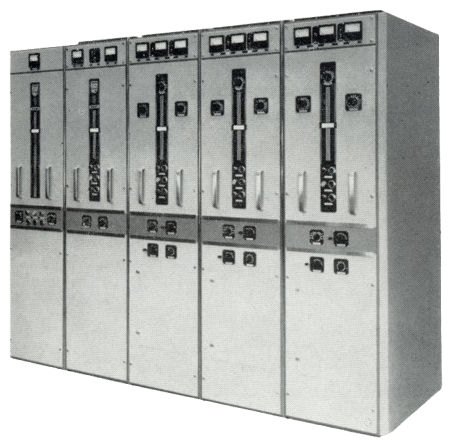| GENERAL DESCRIPTION |
 5 kW AM SHORT-WAVE BROADCAST TRANSMTITER TYPE 8FZ 508 channelized
5 kW AM SHORT-WAVE BROADCAST TRANSMTITER TYPE 8FZ 508 channelized| TECHNICAL SPECIFICATIONS | |
| Carrier power output | 5 kW for the carrier without modulation at nominal mains voltage and frequency |
| Frequency range | 2.2-28 Mc/s in seven sub-ranges |
| Frequency stability | 2.2-4 Mc/s: ± 20.10-6 4-28 Mc/s: ± 15.10-6 |
| RF output impedance | 600 ohms balanced at a max. SWR of 1 : 1.4. To special order 50 or 75 ohms unbalanced |
| RF harmonics | according to CCIR recommendations |
| AF input impedance | nominal 600 ohms balanced |
| AF input level | 0 dBm ± 2 db for 100% depth of modulation by a 1000 c/s signal (0 dBm is 1 mW into 600 ohms) |
| AF response | flat within ± 1.5 dB from 30 to 10,000 c/s reference 1000 c/s at 60% modulation |
| Non linear distortion | less than 3 % from 50 to 10,000 c/s and 2% from 100-7000 c/s at modulation depth of 90% |
| Intermodulation | two signals having frequencies between 5000 and 10,000 c/s and differing 180 c/s, each modulating the transmitter for 30%, will cause an intermodulation percentage of less than 2% for intermodulation products of the 2nd and 3rd order |
| Hum and noise level | lower than -60 dB unweighted and lower than -70 dB weighted. Reference 1000 c/s at 100% modulation |
| Modulation capability | 100% instantaneously and in the 50-10,000 c/s range 60% continuously |
| Carrier amplitude variation | the average deviation of the carrier during modulation, calculated from power measurement made in a dummy load, is less than 5% up to modulation depth of 100% |
| Mains power supplies | 3 x 380 V ±5%, 50 c/s or 60 c/s ±5%; four-wire mains: adaptation to other voltages is possible by use of an optional, separate auto-transformer |
| Power consumption (approximate, for a transmitter with one RF unit) | at 0% modulation 11 kW at 30% modulation 13 kW at 100% modulation 16 kW at stand-by approx. 2.5 kW The consumption per additional RF unit at stand-by is approx. 1 kW The consumption for the modulated transmitter is given for a modulation frequency of 1000 c/s. Average power factor 0.9 |
| Ambient temperatures | at sea level: 0° to 45° C at 6000 feet: 0° to 35° C |
| Relative humidity | up to 95% |
| Dimensions and weight (overall) for a transmitter with one RF unit | height approx. 212 cm (84 in.) width approx. 162 cm (64 in.) depth approx. 87 cm (34 in.) minimum floorspace 300 x 350 cm (10 x 12 ft.) weight unpacked approx. 2500 kg (5500 lb.) |
| TUBE COMPLEMENT | |||||
| RF stages | AF stages and modulator | Rectifiers | |||
| Number | Type | Number | Type | Number | Type |
| 2 | QBL5/3500 (6076) | 2 | QBL5/3500 (6076) | ||
| 3 | QQE06/40 (5894) | 6 | QE06/50 (807) | ||
| 1 | OA2 | ||||
| 1 | E80L (6227) | ||||
| 1 | EF91 (6AM6) | ||||
| THIS TYPE OF TRANSMITTER IS INSTALLED IN THE FOLLOWING COUNTRIES | |||||
| ITU | Country | ITU | Country | ||